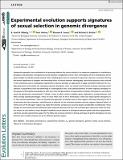Files in this item
Experimental evolution supports signatures of sexual selection in genomic divergence
Item metadata
| dc.contributor.author | Wiberg, Ralf Axel Wilhelm | |
| dc.contributor.author | Veltsos, Paris | |
| dc.contributor.author | Snook, Rhonda | |
| dc.contributor.author | Ritchie, Michael Gordon | |
| dc.date.accessioned | 2021-03-23T11:30:04Z | |
| dc.date.available | 2021-03-23T11:30:04Z | |
| dc.date.issued | 2021-06 | |
| dc.identifier | 272933051 | |
| dc.identifier | 38eeee69-8250-4fce-abbf-255bb268cba1 | |
| dc.identifier | 85102831409 | |
| dc.identifier | 000631278800001 | |
| dc.identifier.citation | Wiberg , R A W , Veltsos , P , Snook , R & Ritchie , M G 2021 , ' Experimental evolution supports signatures of sexual selection in genomic divergence ' , Evolution Letters , vol. 5 , no. 3 , 220 , pp. 214-229 . https://doi.org/10.1002/evl3.220 | en |
| dc.identifier.issn | 2056-3744 | |
| dc.identifier.other | ORCID: /0000-0001-7913-8675/work/91340872 | |
| dc.identifier.uri | https://hdl.handle.net/10023/21688 | |
| dc.description | Funding: Wellcome (Grant Number(s): 105621/Z/14/Z), Natural Environment Research Council (Grant Number(s): NBAF654, NE/I014632/1, NE/L501852/1). | en |
| dc.description.abstract | Comparative genomics has contributed to the growing evidence that sexual selection is an important component of evolutionary divergence and speciation. Divergence by sexual selection is implicated in faster rates of divergence of the X chromosome and of genes thought to underlie sexually selected traits, including genes that are sex biased in expression. However, accurately inferring the relative importance of complex and interacting forms of natural selection, demography, and neutral processes that occurred in the evolutionary past is challenging. Experimental evolution provides an opportunity to apply controlled treatments for multiple generations and examine the consequent genomic divergence. Here, we altered sexual selection intensity, elevating sexual selection in polyandrous lines and eliminating it in monogamous lines, and examined patterns of allele frequency divergence in the genome of Drosophila pseudoobscura after more than 160 generations of experimental evolution. Divergence is not uniform across the genome but concentrated in “islands,” many of which contain candidate genes implicated in mating behaviors and other sexually selected phenotypes. These are more often seen on the X chromosome, which also shows greater divergence in FST than neutral expectations. There are characteristic signatures of selection seen in these regions, with lower diversity on the X chromosome than the autosomes, and differences in diversity on the autosomes between selection regimes. Reduced Tajima's D within some of the divergent regions may imply that selective sweeps have occurred, despite considerable recombination. These changes are associated with both differential gene expression between the lines and sex‐biased gene expression within the lines. Our results are very similar to those thought to implicate sexual selection in divergence between species and natural populations, and hence provide experimental support for the likely role of sexual selection in driving such types of genetic divergence, but also illustrate how variable outcomes can be for different genomic regions. | |
| dc.format.extent | 16 | |
| dc.format.extent | 1314190 | |
| dc.language.iso | eng | |
| dc.relation.ispartof | Evolution Letters | en |
| dc.subject | Experimental evolution | en |
| dc.subject | Sexual selection | en |
| dc.subject | Genomic divergence | en |
| dc.subject | Drosophila pseudoobscura | en |
| dc.subject | FST | en |
| dc.subject | Tajima’s D, Genomic Islands | en |
| dc.subject | X chromosome divergence | en |
| dc.subject | QH301 Biology | en |
| dc.subject | QH426 Genetics | en |
| dc.subject | DAS | en |
| dc.subject.lcc | QH301 | en |
| dc.subject.lcc | QH426 | en |
| dc.title | Experimental evolution supports signatures of sexual selection in genomic divergence | en |
| dc.type | Journal article | en |
| dc.contributor.sponsor | The Wellcome Trust | en |
| dc.contributor.sponsor | NERC | en |
| dc.contributor.institution | University of St Andrews. Centre for Biological Diversity | en |
| dc.contributor.institution | University of St Andrews. Institute of Behavioural and Neural Sciences | en |
| dc.contributor.institution | University of St Andrews. School of Biology | en |
| dc.contributor.institution | University of St Andrews. St Andrews Bioinformatics Unit | en |
| dc.identifier.doi | 10.1002/evl3.220 | |
| dc.description.status | Peer reviewed | en |
| dc.identifier.grantnumber | 105621/Z/14/Z | en |
| dc.identifier.grantnumber | NE/I014632/1 | en |
This item appears in the following Collection(s)
Items in the St Andrews Research Repository are protected by copyright, with all rights reserved, unless otherwise indicated.

